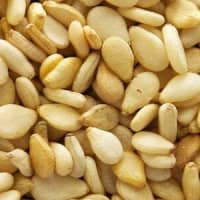Sesame seeds come from the flowering plant Sesamum indicum.
Composition
Sesame has one of the highest oil contents of any seed.
Sesame seeds have lignan contents several times higher than other dietary sources.[1]
The lignan concentrations in sesame seeds (almost 29 mg/100 g, principally pinoresinol and 119 lariciresinol) are relatively high.
Sesamin as a furofuran-type lignan, one of the main lignan compositions in sesame, is present in the seeds in amounts of 0.1-0.5%. Sesamin, can also be converted by intestinal microbiota to the mammalian lignans which may have protective effects against hormone-related diseases such as breast cancer.[1:1]
Sesaminol is a furofuran that is cis-tetrahydro-1H,3H-furo[3,4-c]furan substituted by a 6-hydroxy-1,3-benzodioxol-5-yl group at position 1S and a 1,3-benzodioxol-5-yl group at position 4S. It is metabolite found in sesame seeds.
Healing Properties
Antioxidant
Sesame ingestion benefits postmenopausal women by improving antioxidant status, blood lipids, and sex hormone status.[1:2]
Disease / Symptom Treatment
Parkinson’s Disease
Sesaminol has a preventative effect on Parkinson’s Disease.[2]
Title: The what and who of dietary lignans in human health: Special focus on prooxidant and antioxidant effects
Publication: Trends in Food Science & Technology
Archive: archive ↩︎ ↩︎ ↩︎Title: Sesaminol prevents Parkinson’s disease by activating the Nrf2-ARE signaling pathway
Publication: Heliyon
Archive: archive, archive-mirror ↩︎
